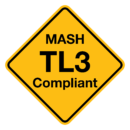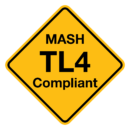MASH TL4 Thrie-Beam Road Safety Barrier.
RamShield® High Containment is the latest innovation and advancement in thrie-beam guardrail barrier designs. Developed by Safe Direction, RamShield® High Containment has been full-scale crash tested to MASH Test Level (TL) 4. Thrie-beam guardrail is a stronger version of the w-beam guardrail systems. The additional corrugation in the rail combined with the higher mounting height, stiffens the barrier and improves its ability to contain larger vehicles.





